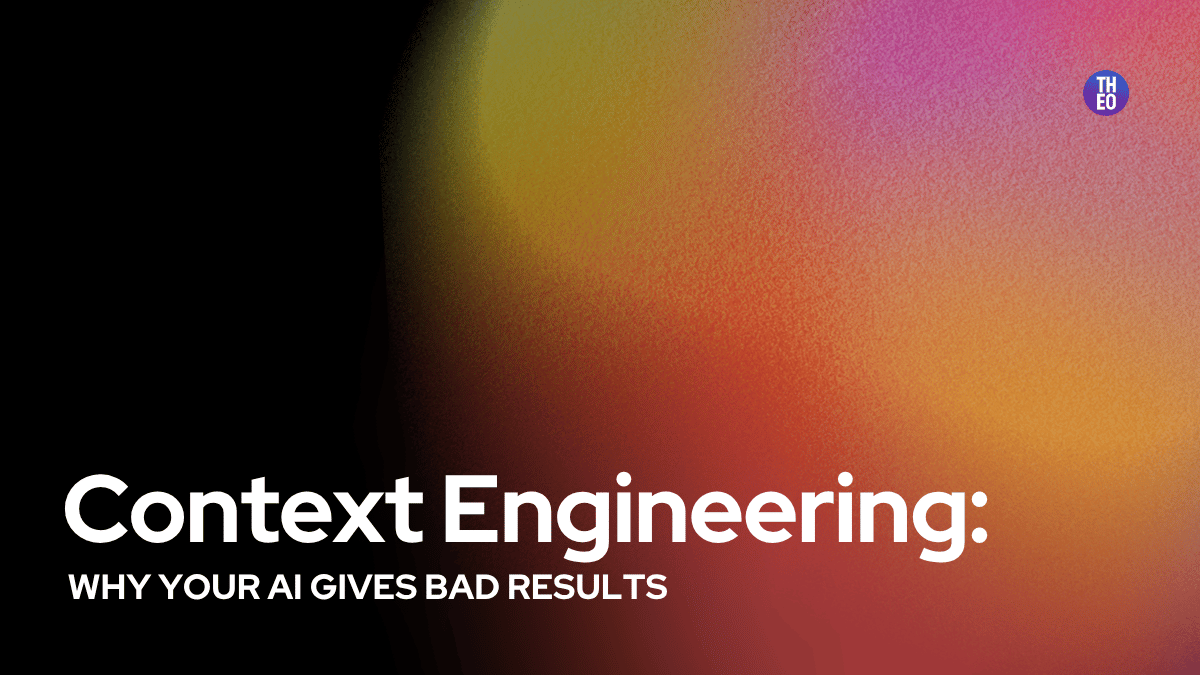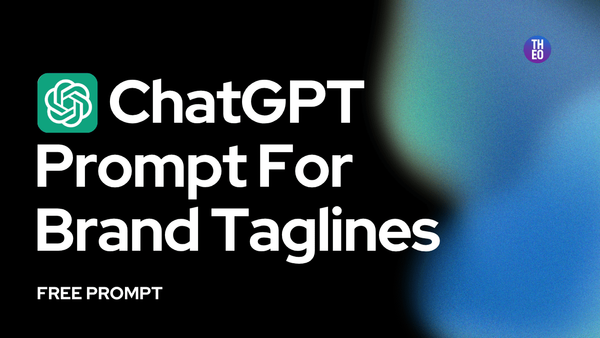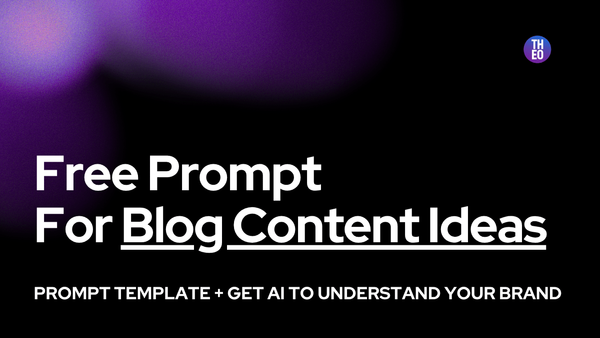Business Context Engineering: Critical 'Context Engineering' Component
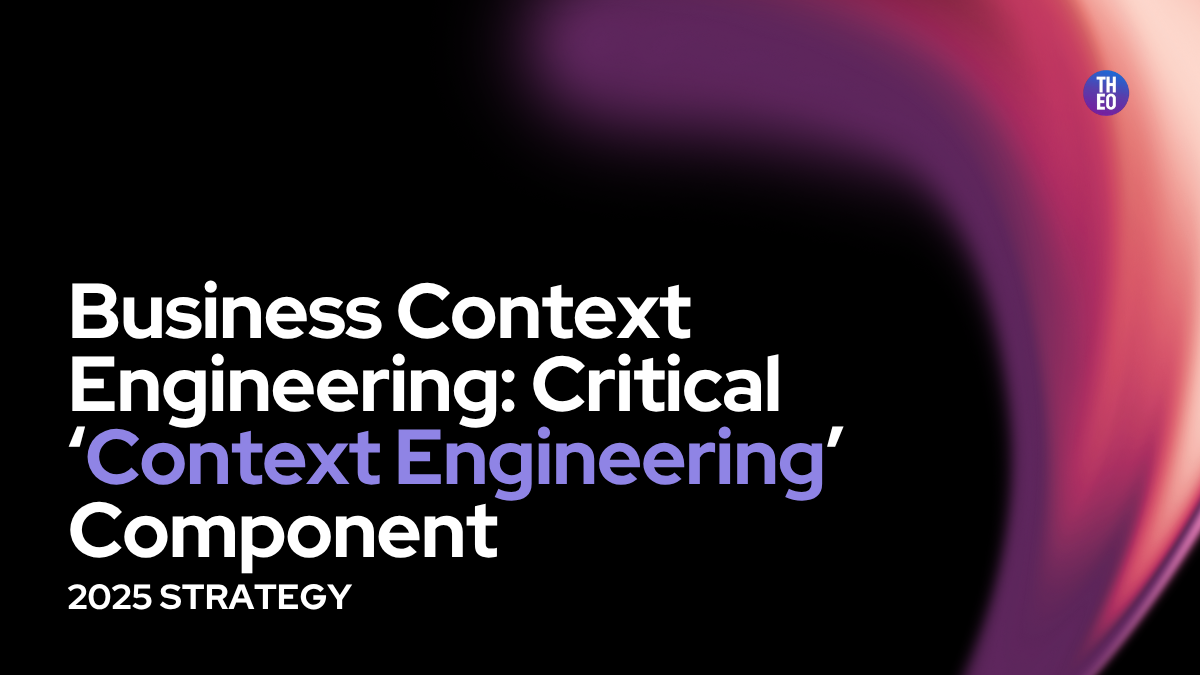
The AI industry has evolved from 'prompt engineering' to 'context engineering'—systematically providing just the right information for AI effectiveness. Industry leaders like Tobi Lutke (Shopify CEO) and Andrej Karpathy (former OpenAI researcher) have declared this shift, with Karpathy noting: "Context engineering is the delicate art and science of filling the context window with just the right information for the next step."
But recent research revealed a critical pattern: AI accuracy drops 39% when conversations require multiple turns to clarify what's needed. While the industry focuses on technical context engineering infrastructure, there's an equally critical component that organizations are skipping: business context engineering—the systematic organization of strategic business intelligence before feeding it into AI systems.
This matters because unclear task definition (poor prompting) OR scattered business information both force AI into the same problematic multi-turn clarification patterns that research proves destroy performance.
What Is Business Context Engineering and Why It Matters
Business context engineering is the systematic organization of comprehensive business intelligence that enables AI to think strategically about your specific market situation. Unlike traditional prompt engineering that focuses on task instructions, business context engineering creates structured "Business DNA" that includes competitive positioning logic, customer decision-making patterns, and strategic market context.
The difference transforms AI from a generic tool into a strategic business partner. When marketing teams implement business context engineering, they report reduced AI iteration cycles by 5-10x while achieving consistent brand voice across all platforms.
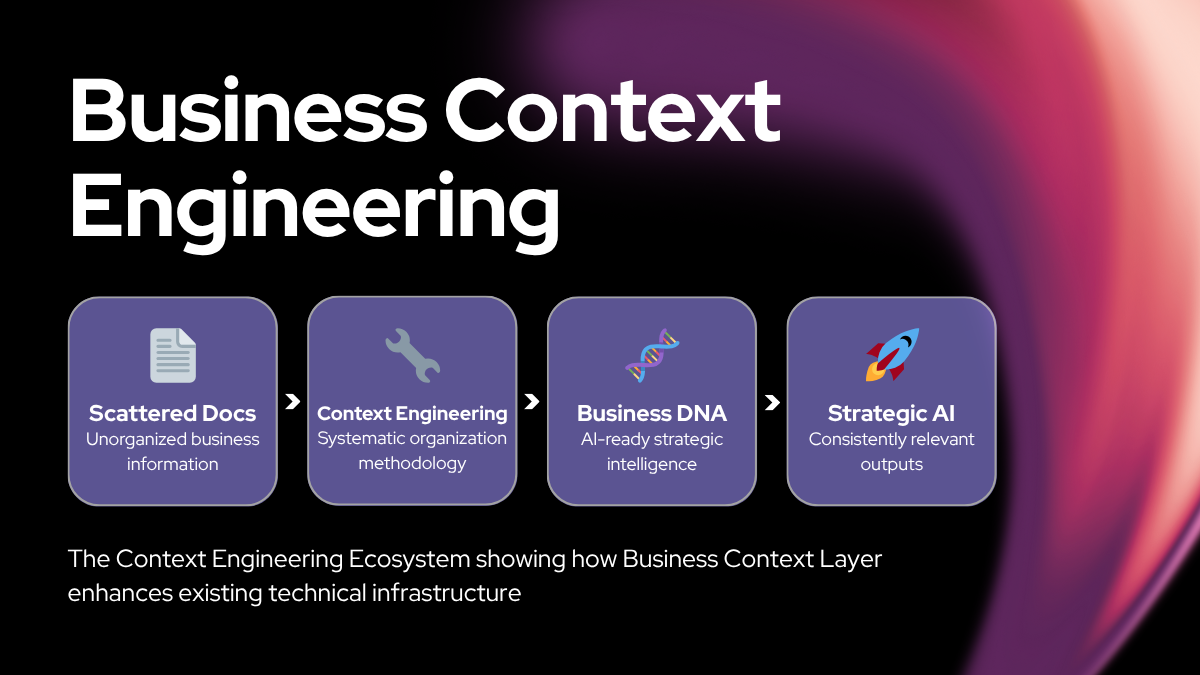
The Critical Gap Most Organizations Miss
Most businesses provide AI with basic company information: mission statements, product descriptions, target demographics. But AI needs comprehensive Business DNA to deliver strategic intelligence:
What Organizations Typically Provide:
- Company description and mission
- Product features and benefits
- Target audience demographics
- Brand voice guidelines
- Scattered documents across sources
What Business Context Engineering Provides:
- Strategic positioning logic and competitive differentiation strategy
- Customer decision intelligence and purchasing psychology
- Competitive context and market dynamics analysis
- Business model rationale connecting pricing to positioning
- Regional intelligence and local market considerations
- Industry regulations and compliance requirements
This systematic approach addresses what we call the "context gap"—the difference between what AI can access and what it needs for strategic thinking.
The Research Proving Business Context Engineering Is Critical
Academic research validates why forcing AI into multi-turn clarification patterns creates systematic failure, while technical community analysis shows how proper context organization dramatically improves performance.
The Academic Evidence
Microsoft and Salesforce AI research across 200,000+ conversations reveals:
- 39% average accuracy drop when moving from single-turn to multi-turn conversations
- 112% increase in response unreliability during extended interactions
- Universal failure pattern across all 15 tested AI models, from GPT-4 to Claude to Llama
The culprit: insufficient information forces AI into ineffective multi-turn patterns. When either task definition is unclear or business context is disorganized, AI must "chat through" multiple exchanges to piece together what it needs to know—and both accuracy and consistency degrade catastrophically with each turn.
This research validates why both clear task definition (effective prompting) AND organized business context (business context engineering) are essential for AI effectiveness.
Technical Community Validation
Leading AI researcher insights prove business context engineering necessity:
Token Efficiency: Scattered business information wastes processing capacity as AI systems struggle with conflicting context. Organized Business DNA ensures every piece contributes to better outputs.
Precision and Relevance: Enterprise AI implementations with systematic business context organization show 60-80% improvement in output relevance and 40-50% reduction in processing overhead.
Memory Engineering: Maintaining consistent context across conversations requires systematic information architecture. Without it, businesses experience "brand drift"—AI outputs varying wildly in strategic alignment.
How Marketing Teams Currently Struggle With Context Engineering
Marketing professionals are already experimenting with context engineering through custom GPTs, Claude Projects, and document uploads. However, most unknowingly limit results by providing basic information instead of comprehensive Business DNA.
The Current Reality Check
What Most Teams Do:
- Upload brand guidelines and product specs to create "marketing assistants"
- Create custom GPTs with basic company information
- Manually explain business context in each conversation
- Rebuild setups when switching between AI platforms
The Results They Get:
- Outputs requiring extensive strategic revision
- Inconsistent brand voice and messaging
- 12+ hours weekly explaining business nuances
- Generic recommendations lacking competitive insight
Why Basic Information Falls Short: Basic company information tells AI what you do, but not why you do it strategically. AI can follow brand guidelines but can't think about competitive positioning. It targets demographics without understanding customer decision psychology.
The Real Cost of Scattered Context
Marketing teams report spending 12+ hours weekly repeatedly explaining business nuances, leading to:
- Generic outputs requiring 10-18 iterations per piece
- Extensive editing to maintain brand consistency
- Constant re-explanation across conversations and platforms
- Inability to execute sophisticated multi-product campaigns
This inefficiency prevents exactly the strategic marketing activities where AI should provide most value.
Business Context Engineering Implementation: From Basic to Strategic
The transformation from scattered context to strategic Business DNA becomes clear through practical implementation. Here's how the same marketing task evolves across different context engineering approaches.
The Three-Stage Evolution
Stage 1: Traditional Prompt Engineering
Task: "Write a product launch announcement for our new CRM automation feature targeting small business owners with conversational, empathetic voice emphasizing 5-minute setup."
Result: Limited by prompt constraints, generic outputs lacking strategic depth or competitive nuance.
Stage 2: Basic Context Engineering
Same task with: 47 scattered marketing documents, various brand guidelines with conflicting information, random competitive analyses from different periods.
Result: "Middle amnesia"—AI misses or misinterprets information buried in scattered documents. Output quality varies based on which random documents AI accesses first.
Stage 3: Business Context Engineering
Same task with organized Business DNA:
- Strategic positioning logic and competitive differentiation strategy
- Customer decision intelligence for small business psychology
- Competitive context and market positioning rationale
- Brand foundation with strategic messaging hierarchy
Result: Strategically sophisticated content that thinks like your business. AI considers competitive strategy when emphasizing differentiation, understands customer psychology for announcement structure, aligns messaging with broader market positioning.
Real-World Transformation Examples
Strategic Planning Sessions:
- Basic Context: Generic campaign frameworks and standard tactics
- Business DNA Context: Strategic recommendations aligned with differentiation strategy, referencing actual competitive advantages, considering customer decision timeline
Crisis Communication:
- Basic Context: Standard corporate damage control language
- Business DNA Context: Authentic response reinforcing value proposition while addressing concerns consistently with business approach
Content Strategy Development:
- Basic Context: Generic content marketing templates and standard timeline
- Business DNA Context: Strategic content sequence guiding prospects through specific customer journey while reinforcing competitive advantages at decision-critical moments
The CLEAR™ Framework for Business Context Engineering
Systematic Business DNA organization requires the CLEAR™ methodology - a proven framework for transforming scattered business information into strategic intelligence.
CLEAR™ Implementation Steps
C - Contextual Ownership: Each piece of business intelligence has clear authoritative source and strategic purpose
L - Linking: Strategic relationships between business concepts are explicitly mapped (how positioning connects to pricing, how customer insights inform competitive strategy)
E - Elimination: Conflicting information is resolved to prevent AI confusion about strategic direction
A - Authority: Clear precedence for business decisions and strategic priorities
R - Refinement: Continuous optimization based on AI effectiveness and business evolution
Strategic Integration vs Document Organization
| Traditional Document Organization | Business Context Engineering |
|---|---|
| Storage and retrieval focus | Strategic coherence focus |
| "Here are brand guidelines, personas, competitive analysis" | "Here's how brand positioning connects to competitive strategy" |
| Information silos | Strategic relationship mapping |
| Generic business information | Comprehensive Business DNA |
The difference is strategic integration—Business DNA doesn't just organize information, it maps strategic relationships enabling AI to think strategically about your business.
Implementation Benefits
Primary Business Purpose: Create systematic organizational intelligence enabling superior decision-making, consistent execution, and strategic competitive positioning.
Measurable Outcomes:
- 5-10x fewer iteration cycles due to strategic alignment
- Consistent brand voice across all AI-generated content
- Cross-platform consistency working with any AI tool
- Scalable team implementation enabling strategic thinking across marketing operations
Business Context Engineering Best Practices and Common Mistakes
Success with business context engineering requires understanding both effective practices and frequent pitfalls organizations encounter during implementation.
Essential Best Practices
Comprehensive Strategic Mapping: Include not just what you do, but why you do it strategically. Map connections between competitive positioning, customer psychology, pricing strategy, and market approach.
Regional Context Integration: Even small geographic details significantly impact AI recommendations. Atlanta-based service companies need different networking strategies than Silicon Valley startups when AI understands regional business culture.
Seasonal Pattern Documentation: Include cyclical business patterns, customer behavior changes, and timing considerations that affect strategic recommendations.
Competitive Context Depth: Go beyond competitor lists to include strategic positioning rationale, market dynamics analysis, and differentiation logic.
Common Implementation Mistakes
Treating Business DNA Like Basic Information: Uploading scattered documents without strategic integration creates the same problems as no context engineering.
Ignoring Strategic Relationships: Organizing information without mapping how different business elements connect strategically limits AI's ability to think holistically.
Underestimating Detail Impact: Seemingly minor contextual elements like industry regulations, local market dynamics, and cultural considerations significantly affect AI output quality.
Platform-Specific Implementation: Creating context engineering that only works with one AI tool instead of systematic Business DNA that transfers across platforms.
Measuring Business Context Engineering Success
Effective business context engineering implementation requires tracking both operational metrics and strategic outcomes to validate ROI and guide optimization efforts.
Key Performance Indicators
Operational Efficiency Metrics:
- Reduction in AI output iteration cycles (customer reports: 5-10x fewer)
- Time saved on context explanation (target: 12+ hours weekly)
- Cross-platform consistency scores
- Team adoption and usage rates
Strategic Quality Metrics:
- Brand voice consistency across AI outputs
- Strategic alignment of AI recommendations
- Competitive differentiation accuracy in content
- Customer psychology reflection in messaging
Business Impact Metrics:
- Marketing campaign performance improvements
- Content creation productivity gains
- Team scaling capability enhancements
- Strategic decision-making speed increases
ROI Calculation Framework
Organizations typically achieve 5-10x productivity improvement when AI operates with comprehensive Business DNA. Calculate ROI by measuring:
- Time savings on revision cycles × hourly team costs
- Improved campaign performance × revenue impact
- Team scaling capability × hiring cost avoidance
- Strategic decision speed × opportunity cost reduction
Advanced Business Context Engineering Strategies
As organizations mature in business context engineering implementation, advanced strategies enable even greater strategic value from AI partnerships.
Multi-Product Context Management
Challenge: Companies with multiple product lines need clean separation preventing context contamination while enabling strategic integration.
Solution: Systematic context architecture with:
- Dedicated product context containers with strict boundaries
- Strategic integration layer for controlled multi-product campaigns
- Audience segmentation framework preventing confusion
- Temporal pattern management for different seasonal cycles
Crisis Coordination Protocols
Advanced Implementation: Business DNA includes crisis response frameworks enabling AI to maintain strategic coherence during challenging situations while adapting messaging appropriately for different stakeholder groups.
Regional Expansion Context
Strategic Application: Business DNA architecture supporting geographic expansion with systematic context management for different regional markets, regulatory environments, and cultural considerations.
The Future of Business Context Engineering
Business context engineering represents the evolution from basic AI usage to strategic AI partnership, with emerging trends pointing toward even more sophisticated implementations.
Emerging Developments
Intelligent Context Refinement: AI systems that can suggest Business DNA improvements based on output effectiveness analysis.
Automated Strategic Relationship Mapping: Tools that identify implicit connections between business concepts for enhanced strategic integration.
Cross-Platform Context Synchronization: Systematic approaches for maintaining Business DNA consistency across multiple AI tools and platforms.
Team Collaboration Frameworks: Methodologies enabling multiple team members to contribute to Business DNA while maintaining strategic coherence.
Industry Adoption Patterns
Organizations implementing comprehensive business context engineering report transformational improvements in AI strategic value. Early adopters gain competitive advantages through superior AI-enabled decision-making, while late adopters struggle with generic outputs limiting strategic capability.
The future belongs to organizations mastering both technical context engineering infrastructure and systematic business context organization—creating AI partnerships that think strategically about unique business situations.
Don't let scattered business information limit your AI effectiveness. The systematic organization of business context is the organizational step that transforms AI from a decent tool into a strategic advantage.
FAQ
What is the difference between context engineering and business context engineering? Context engineering focuses on technical infrastructure like RAG systems and knowledge graphs, while business context engineering systematically organizes strategic business intelligence including competitive positioning, customer psychology, and market dynamics to enable AI strategic thinking.
How long does it take to implement business context engineering? Initial Business DNA organization typically takes 2-4 weeks depending on business complexity, with ongoing refinement requiring 2-4 hours monthly. Most organizations see immediate improvements in AI output quality and strategic alignment.
Can business context engineering work with any AI platform? Yes, systematic Business DNA organization works across all major AI platforms including ChatGPT, Claude, Gemini, and Bing Copilot. The organized context transfers between tools, eliminating platform-specific setup requirements.
What's the ROI of business context engineering implementation? Organizations typically achieve 5-10x productivity improvement with significantly fewer iteration cycles, 12+ hours weekly time savings, and consistent brand voice across all AI outputs. ROI calculations should include time savings, campaign performance improvements, and strategic decision speed increases.
How is Business DNA different from basic company information? Basic company information includes mission statements and product descriptions. Business DNA encompasses strategic positioning logic, customer decision intelligence, competitive context, business model rationale, and regional considerations that enable AI strategic thinking.
What are common business context engineering implementation mistakes? Common mistakes include treating Business DNA like scattered documents, ignoring strategic relationships between business concepts, underestimating detail impact, and creating platform-specific implementations instead of universal systematic organization.
Key Takeaways
- Business context engineering systematically organizes strategic business intelligence enabling AI to think strategically about your specific market situation
- Research validates that scattered business context causes 39% accuracy drops and 112% reliability decreases in AI interactions
- Business DNA differs from basic company information by including competitive positioning logic, customer psychology, and strategic market context
- The CLEAR™ framework provides systematic methodology for transforming scattered business information into strategic intelligence
- Implementation results in 5-10x fewer iteration cycles, consistent brand voice, and cross-platform AI compatibility
- Advanced strategies include multi-product context management, crisis coordination protocols, and regional expansion frameworks
- ROI measurement should track operational efficiency, strategic quality, and business impact metrics
- Future adoption creates competitive advantages through superior AI-enabled strategic decision-making capability
💡 Wait, what if you could set-up an AI that writes in your brand voice in just a 2-minutes? What if it would save you 12+ hours weekly on repetitive marketing tasks?
See how → or get weekly AI marketing tips that actually work for marketing teams.


